Radio Shack Family Favorites 5 in 1 Remote Pdf
You will never look at the headphone jack and plug the same mode again.
Headphone jack is dead!
Apple has killed the headphone jack.
Sounds familiar? Ever since Apple removed the headphone jack from the iPhone 7 in favor of a lightning port, other smartphone companies have quickly followed adapt with the removal of the once omnipresent port.
"I am Jack's complete lack of surprise."
-Fight Club
There are still a few major companies like LG and Samsung who choose to release their flagships with the headphone jack, but I doubtable that could change with the upcoming trend of true wireless headphones.


The truth is that about mainstream consumers don't care for the headphones jack. Proficient riddance, they say.
So, why should you intendance so?
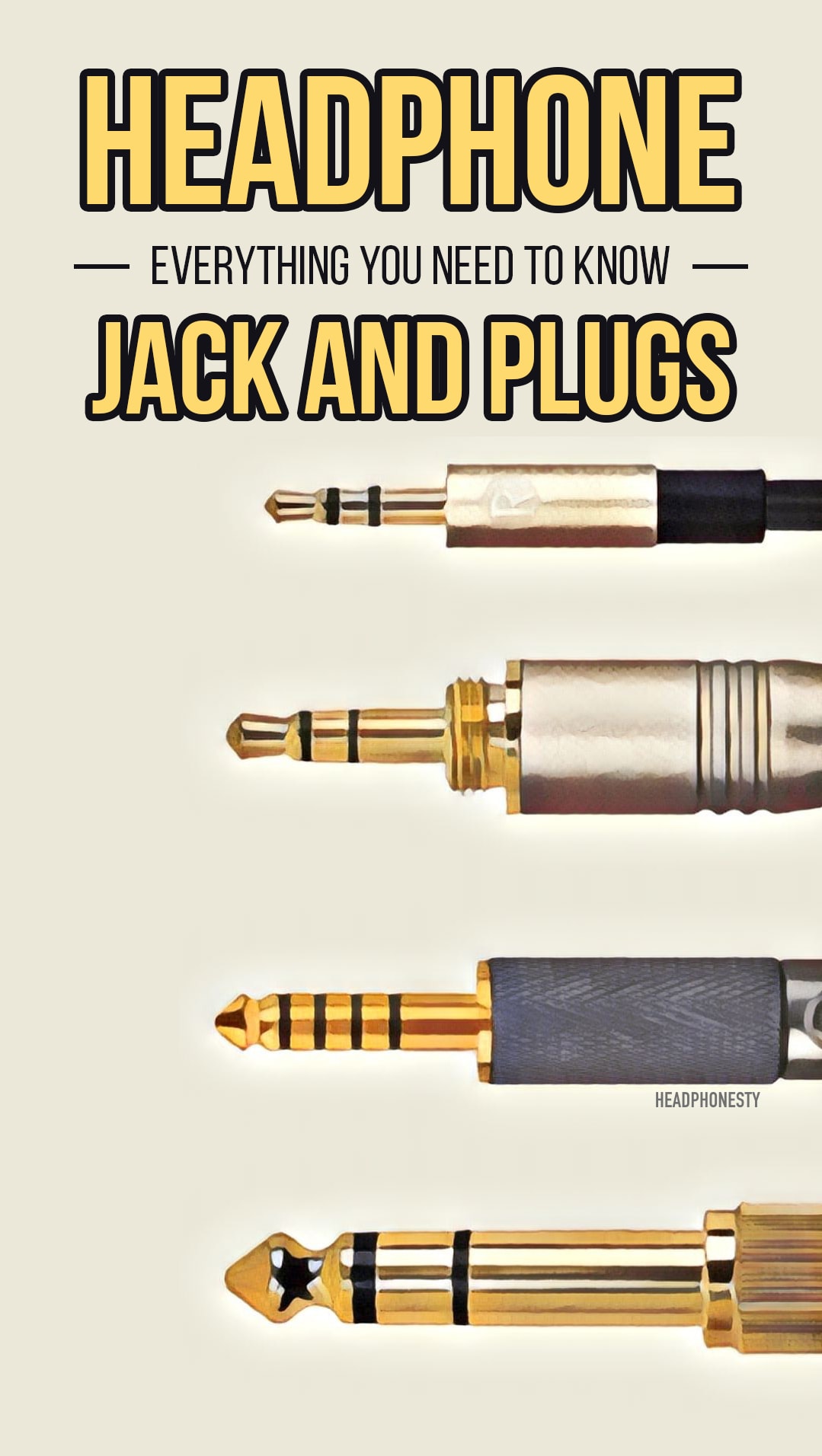
Who Is This Guide For?
- Do you want to enjoy audiophile headphones that only have a wired connection?
- Are you looking to purchase an amplifier for your headphones?
- Are you looking to buy and upgrade your audio cable?
- Do you want to attempt balanced audio?
If you answered yeah to any of the above questions, this guide is for y'all.
By the end of the guide, you will exist comfortable with terms like:
- 3-pole mini
- Stereo mini
- three.5mm single-concluded (or unbalanced) cable
- 2.5mm balanced cable
Difference between a Headphone Jack and Headphone Plug
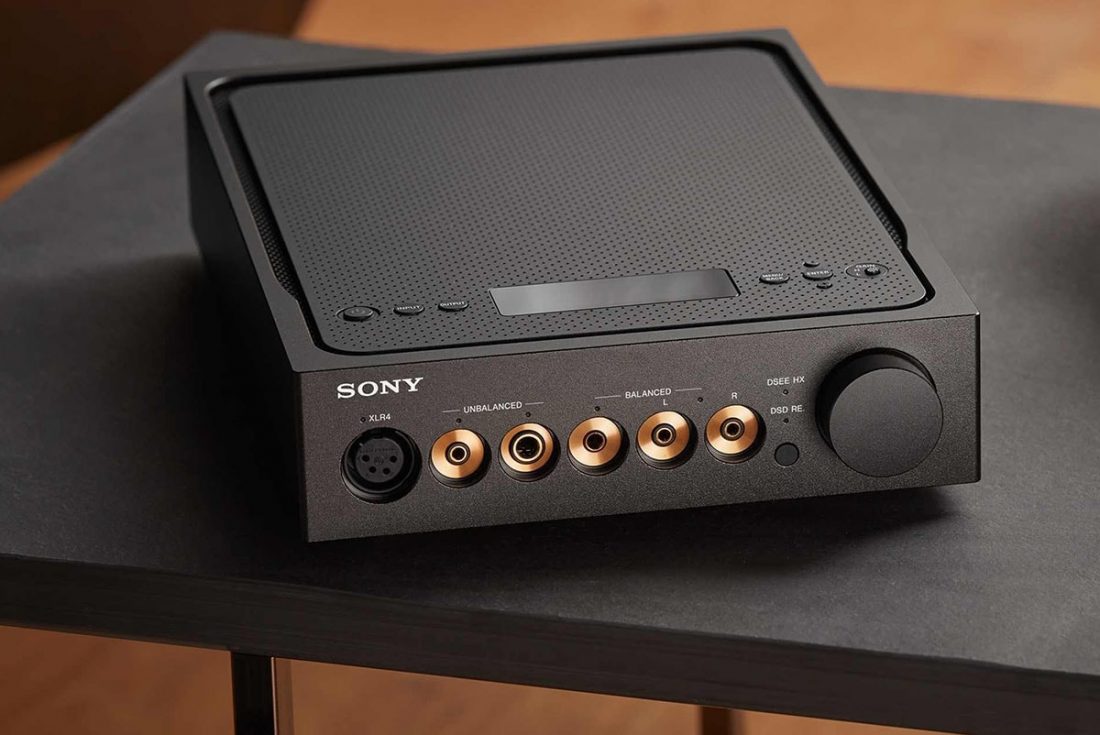
Do you come across these sockets that the above Sony TA-ZH1ES have? Those are headphones jacks. Information technology is where you insert the headphone plugs to receive audio signals.
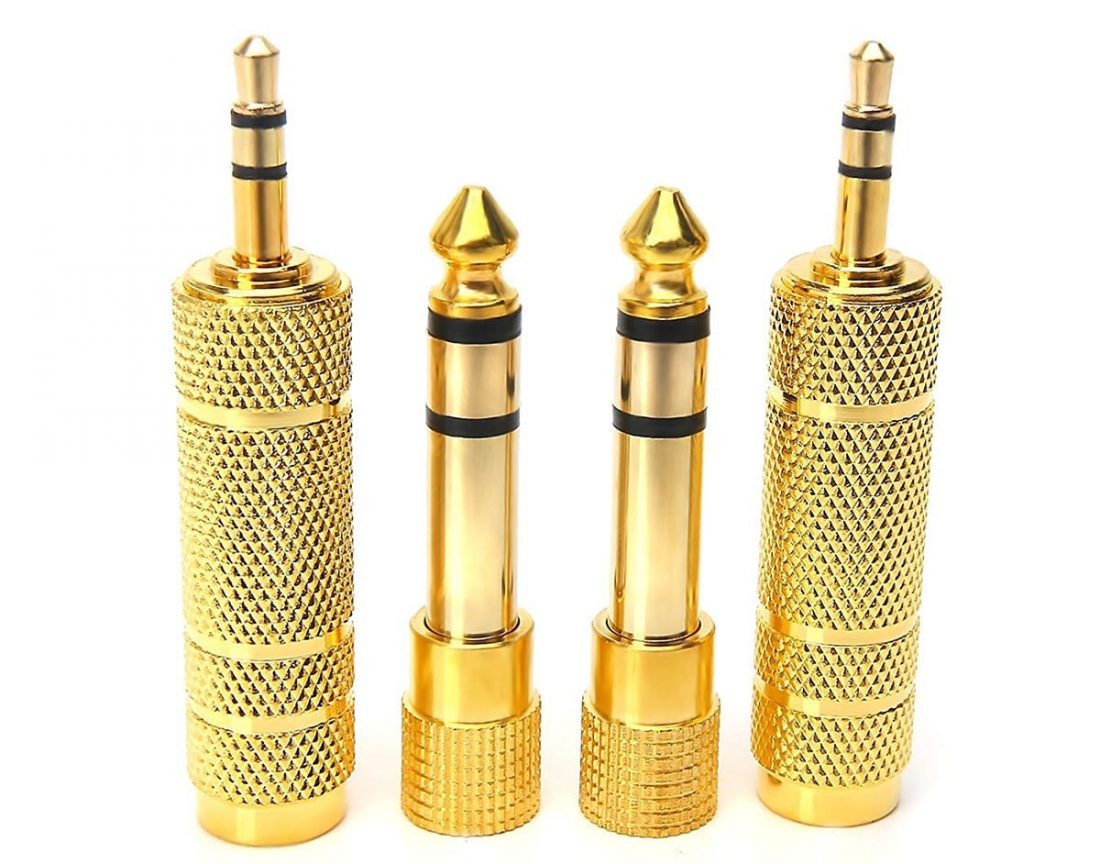
The headphone jack is a family unit of electrical connectors that are typically used for analog audio signals. It is too known past other names like telephone jack, audio jack, aux input, etc.
In that location are cases where headphone jack are used for digital audio signals. For example, the Google Chromecast tin output either analog or digital signals off its single 3.5mm output jack
Female and male connectors
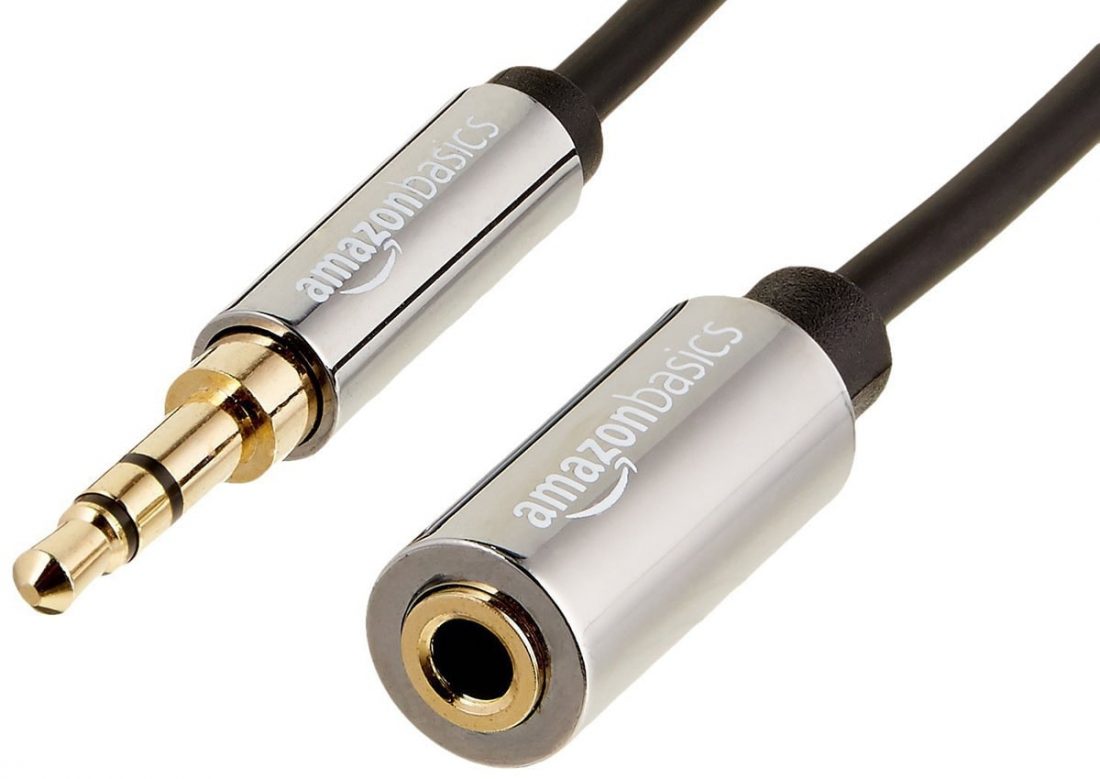
From Amazon. Male Connector (L) Female person Connector (R)
In electric and mechanical trades and manufacturing, each half of a pair of mating connectors or fasteners is conventionally assigned the designation male or female person. – Wikipedia
Unfortunately, the audio industry has non unified in the mode the electrical and mechanical trades have to draw the different gender of connectors. Y'all will often find the give-and-take "plug" used to describe the male person connectors while "jack" used to describe the female connectors.
Development of the Headphone Jack
Who is jack?
The origin of the term "jack" can be traced back to 1874 when C.E. Scribner patented, what he calls, a "jack-pocketknife" connector.
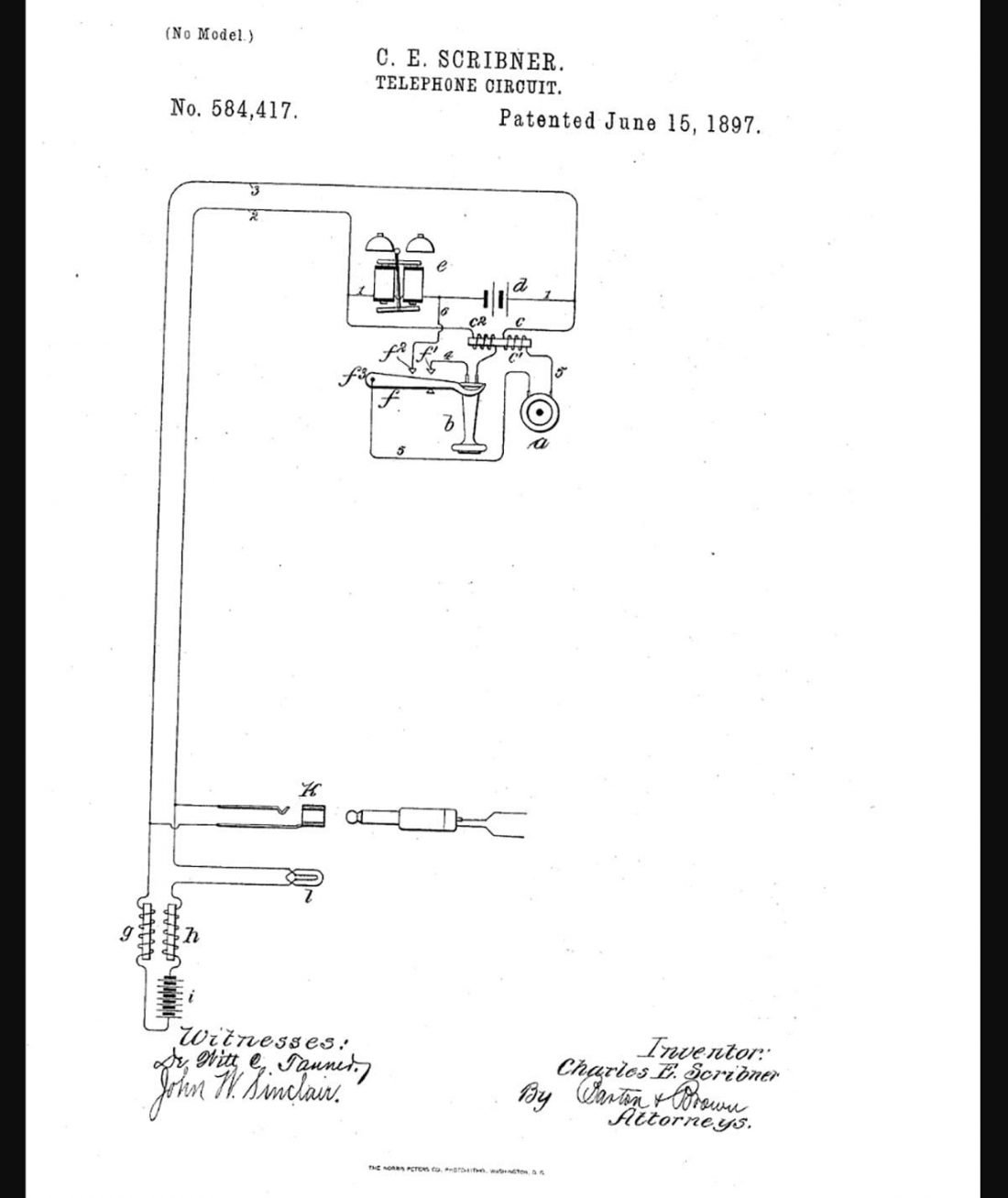
The primeval known jack was a ¼ inch (6.35mm) version and still has mainstream usages which nosotros describe below.
Rounded to pointed tip profile
In the early evolution days, there were many different jack designs. The rounded tip design was especially popular because information technology was compatible with different manufacturers. The rounded tip apace gained traction as the de-facto tip profile for sound equipment.
Simply with the ascension of stereo sound, a unlike tip profile was needed to prevent the old rounded tip from frying the excursion when inserted into incompatible equipment. A pointed tip jack volition preclude a rounded tip plug from being inserted fully, hence solving the problem.
Beefcake of a Headphone Plug
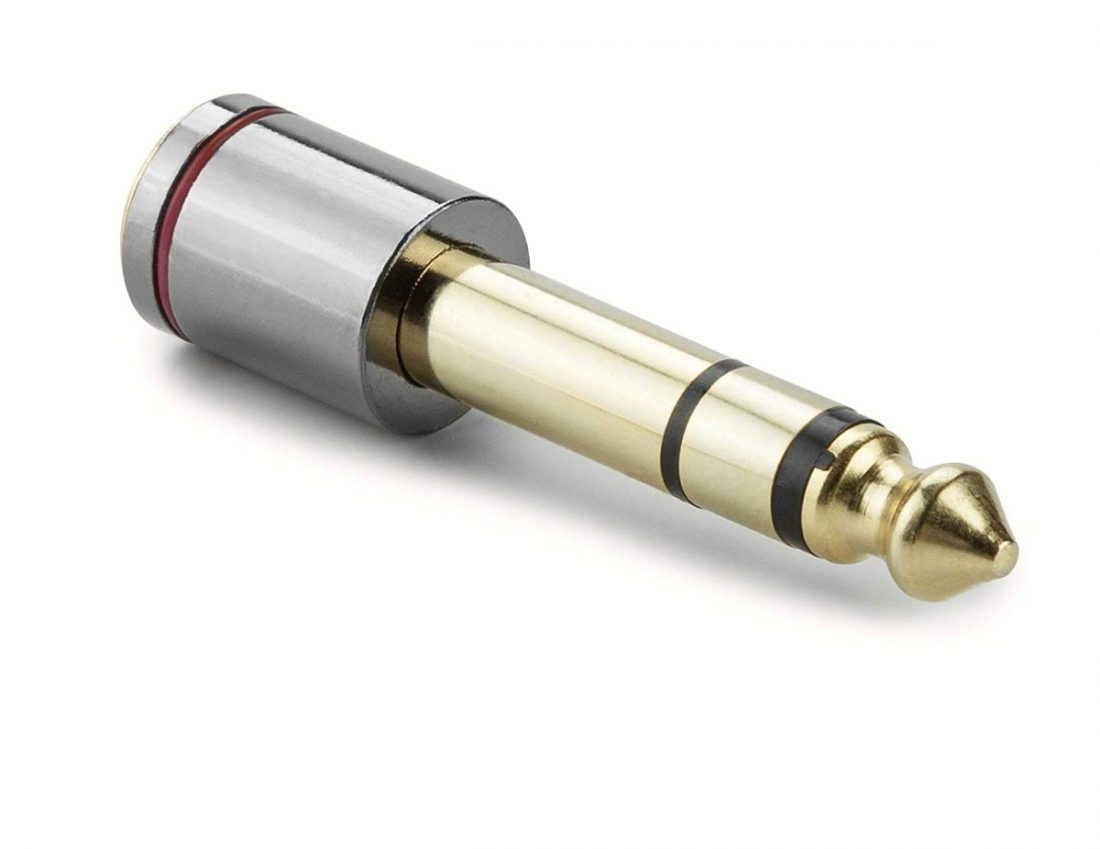
Conductors
Regardless of the plug size, all headphone plugs have conductors. Conductors are the contact points of the plugs that close the circuit.
A headphone plug has a minimum of ii conductors and ordinarily up to v.
If it has 3 conductors, it may be chosen a iii conductor plug. Some manufacturer uses pole to supervene upon conductor. Hence, it tin can also exist called a 3 pole plug.
Identifying conductors.
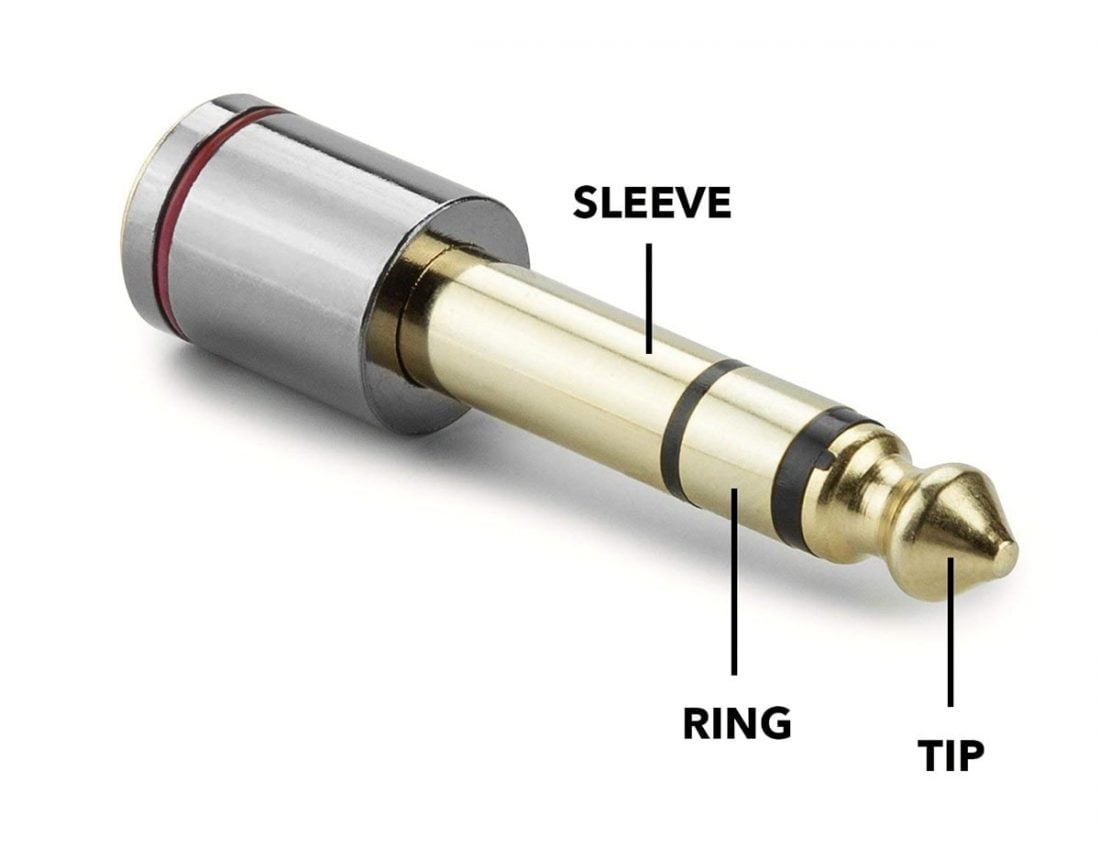
Each conductor has a specific name:
- Tip (T)
- Ring (R)
- Sleeve (S)
All plugs accept at least a Tip and Sleeve. Information technology is the number of Rings that differentiate them. If the plug only has ane ring, it is a 3 conductor plug or a TRS connector. If it has ii rings, it is a 4 conductor plug or a TRRS connector.
Don't mistake the black band as a band. It is an insulating band. The band separates the parts of the plug from beingness shorted together.
Classification of the Headphone Plug:
- 2 usher, 2 pole, TS
- 3 conductor, iii pole, TRS
- 4 usher, 4 pole, TRRS
- 5 conductor, 5 pole, TRRRS
Unlike Plug Connectors configuration
Depending on bachelor conductors, manufacturers can cull to configure jack and plug in diverse ways. Both must be complementary to each other.
2 conductor plug (TS)
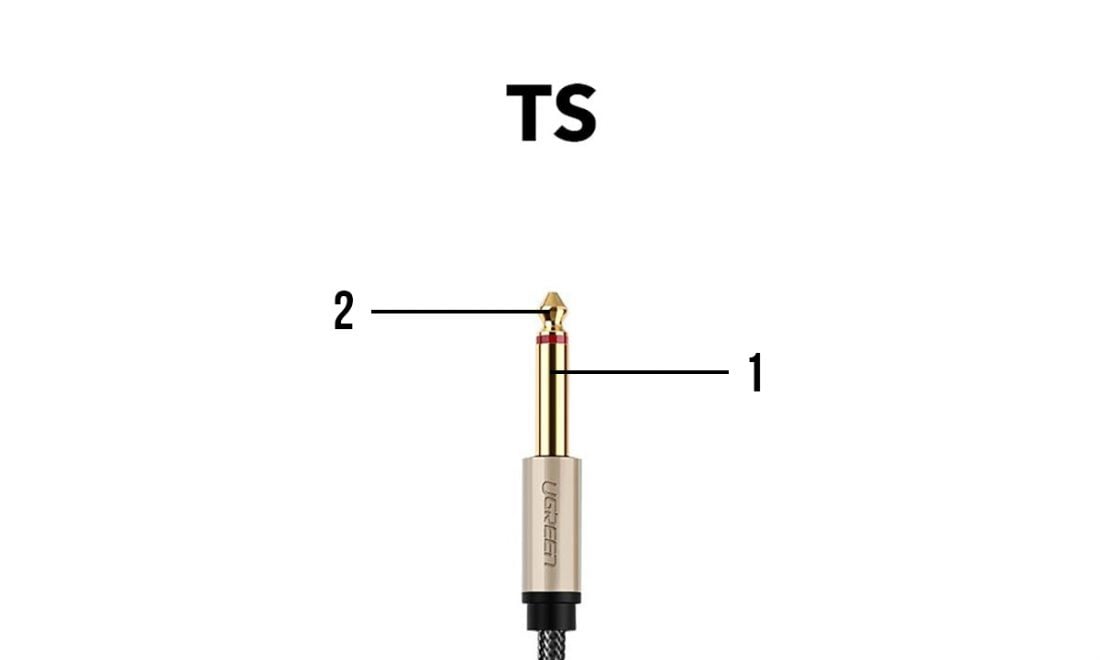
Bachelor Connectors: Merely the tip and sleeve connectors are bachelor.
Connectors Connection:
| Pivot | Office |
|---|---|
| one | Footing |
| two | Signal |
The connection is fairly straightforward here. One connector is used to carry the sound point while the other acts every bit a return path and footing.
The ground acts as a reference point for the signal but it also picks up interference noises like an antenna. The longer the cable, the higher risk the more noise will exist picked up.
Mutual Usage: You can discover TS connectors mainly with guitars, instruments, and applications that practise not crave a long cable connection.
3 conductor plug (TRS)
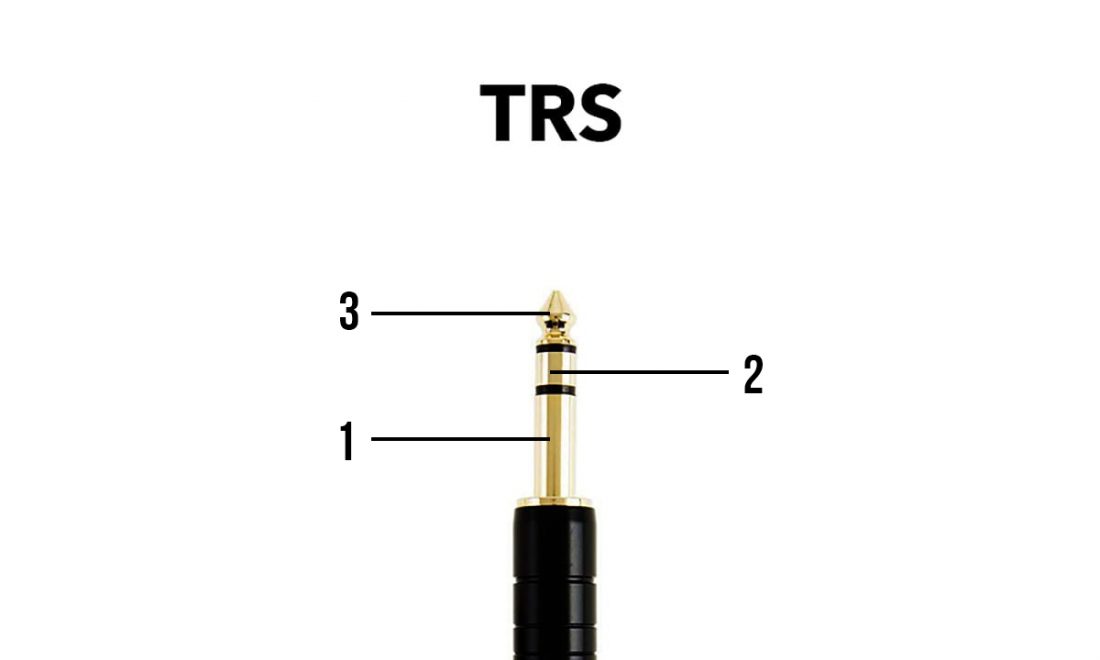
Available Connectors: Bated from the tip and sleeve, in that location is an additional ring connector with 2 insulating bands around information technology.
Connectors Connection:
| Pin | Unbalanced Mono | Balanced Mono | Unbalanced Stereo |
|---|---|---|---|
| 1 | Ground | Ground | Ground |
| 2 | Optional (Mic etc) | Signal - (Common cold) | Right Audio Channel |
| iii | Signal | Point + (Hot) | Left Audio Channel |
With the improver of another usher "R", we open upwardly dissimilar possibilities such equally supporting balanced mono signals and unbalanced stereo signals.
As seen in the "Unbalanced Mono" column in a higher place, the engineer can choose to make use of the additional conductor to acquit a microphone signal instead. In this instance, where the audio is unbalanced, nosotros may also sometimes refer to this as a single-ended plug.
TRS still cannot carry a balanced stereo signal. For that, see TRRRS connector below.
Mutual Usage: Most common form of jack connectors. Yous encounter these on the end of most stock headphone cables.
4 usher plug (TRRS)
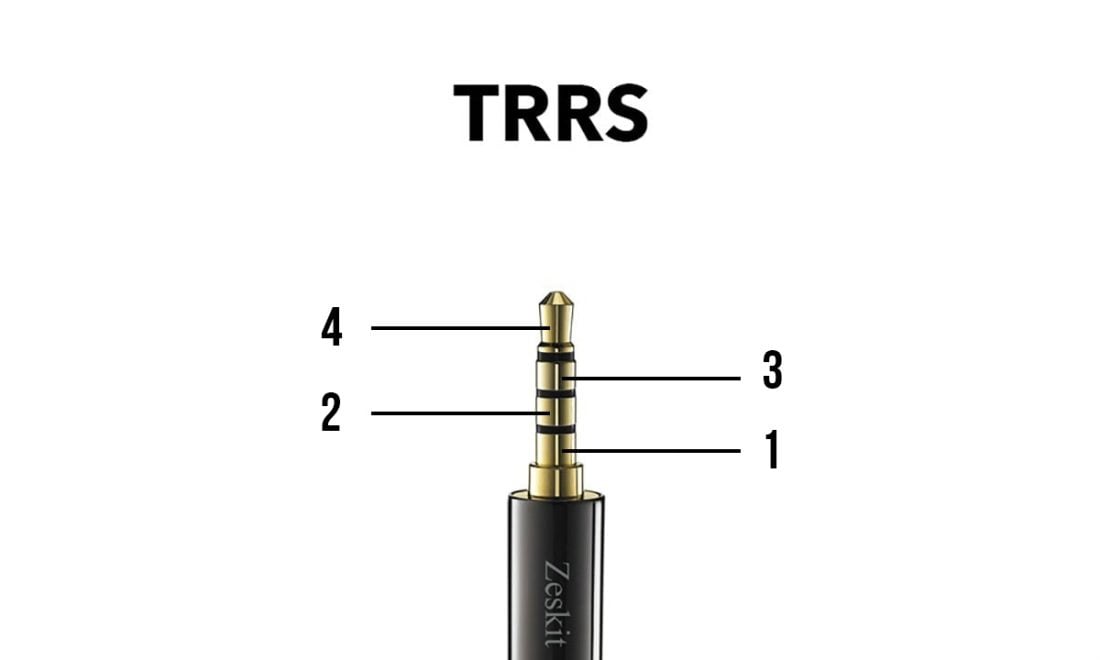
Bachelor Connectors: With a 4 usher plug, we have two additional rings with three insulating bands.
Connectors Connection:
| Pin | Role |
|---|---|
| 1 | Microphone |
| 2 | Ground |
| 3 | Right Sound Channel |
| 4 | Left Audio Channel |
The above connection configuration follows the Cellular Telecommunications and Internet Association (CTIA) standards. Such a connection format is besides called the CTIA TRRS jack connector format.
Common Usage: It is the nearly unremarkably adopted standard for modern smartphones and gaming consoles where the cable supports a microphone and stereo audio connection at the same time.
five conductor plug (TRRRS)
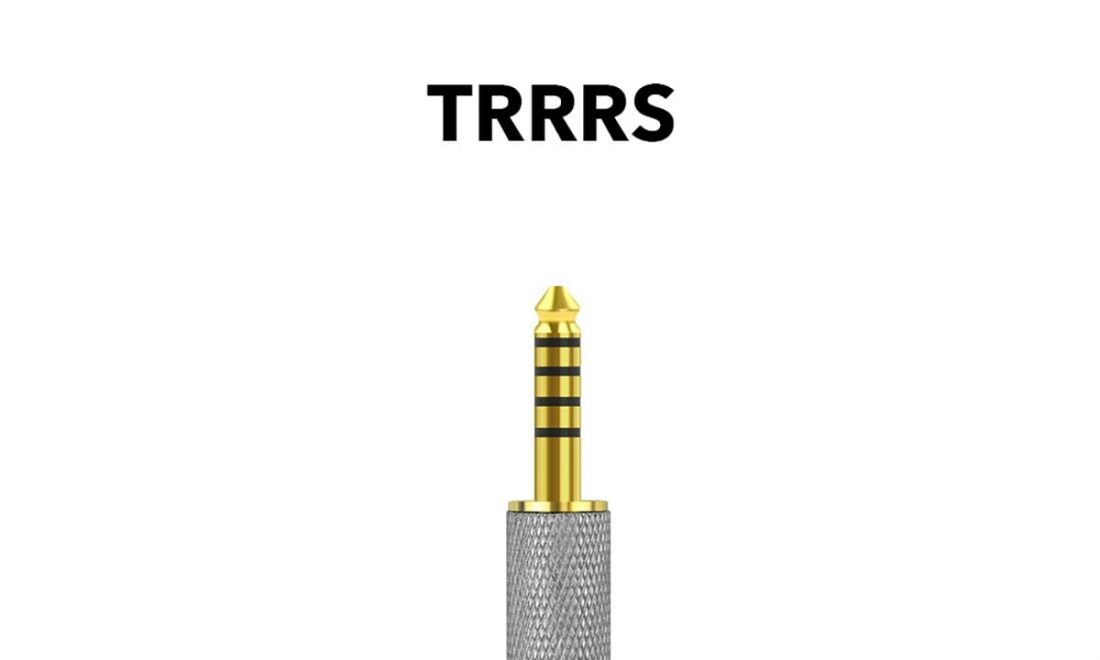
Available Connectors: For a v conductor headphone plug, nosotros have 3 band connectors.
TRRRS connectors are used to back up balanced stereo signal. You will notice that XLR connectors (3 pin pairs, 4 pin, and v pin) are also a common choice for stereo balanced headphones. XLR connectors have been the standard balanced connector in the professional sound market for decades.
It is no surprise that when balanced headphone connections grew in popularity, the standard XLR became a go-to solution.
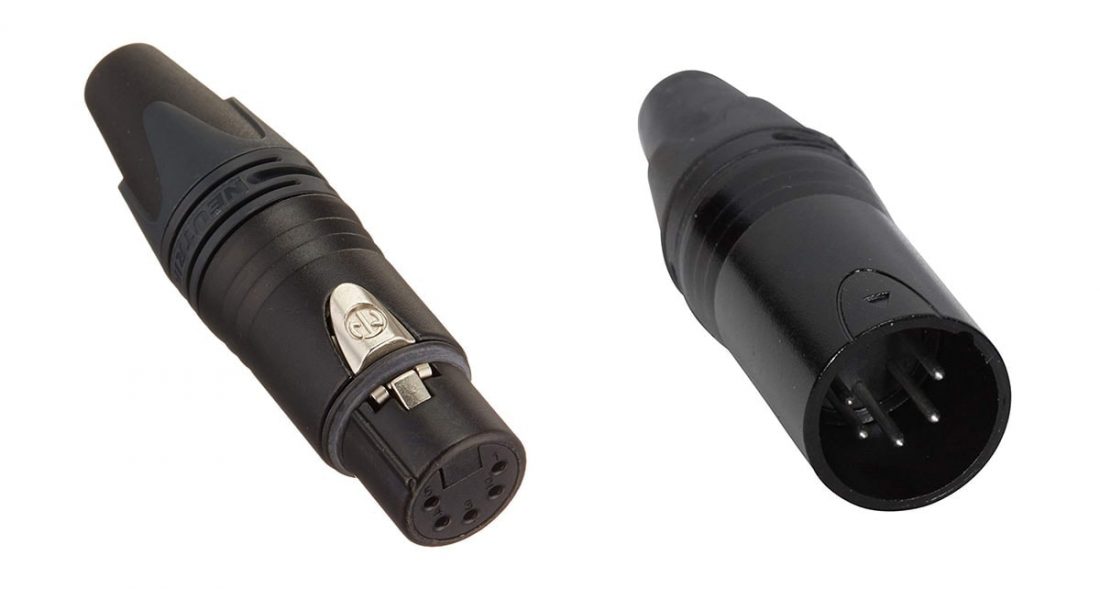
Unlike TRS connectors, XLR connectors take pins instead of tips, rings, and sleeve. All the same, they work the same way. The XLR5 connector has 5 conductors but similar a TRRRS connector.
Sony did brand a TRRRS headphone jack – 4.4mm Pentaconn connector.
Penta means "5" and conn is short for connector.
Please exist enlightened that the Pentaconn connectors are new and not adopted widely by the manufacture. You lot either have to go an adaptor to accommodate the five pole connector or purchase a uniform Sony amplifier.
If y'all are looking to brand your own DIY cablevision with the iv.4mm Pentaconn connector, check out moon sound shop.
Schematic of a headphone jack and plug
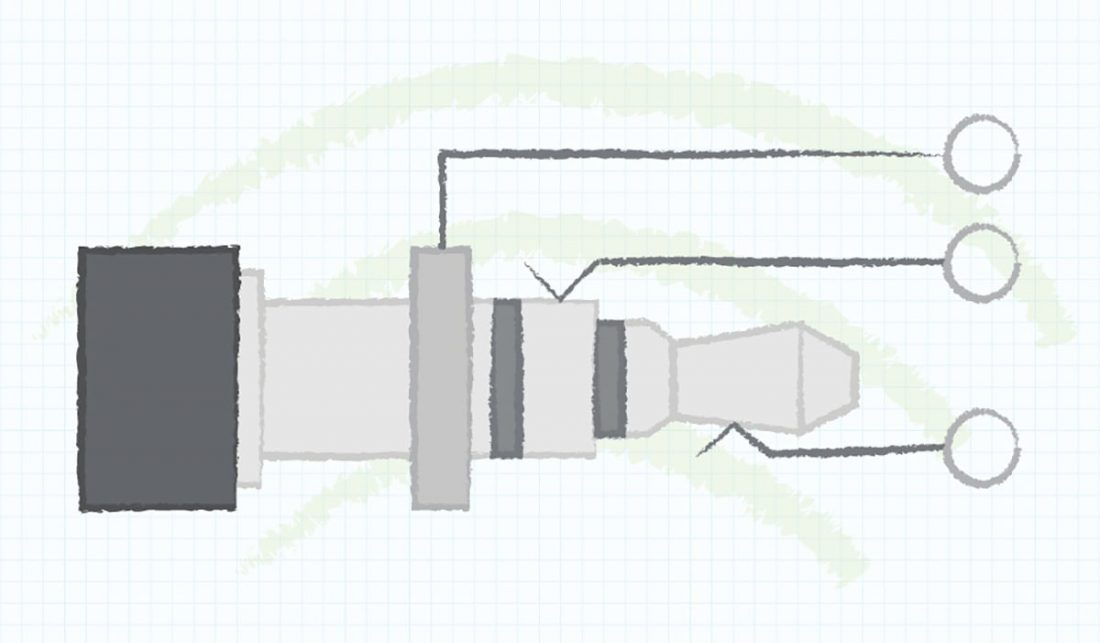
If you are interested in the schematic of a headphones jack, you can hop on over here for a more detailed article.
Different sizes of headphone jacks/plugs
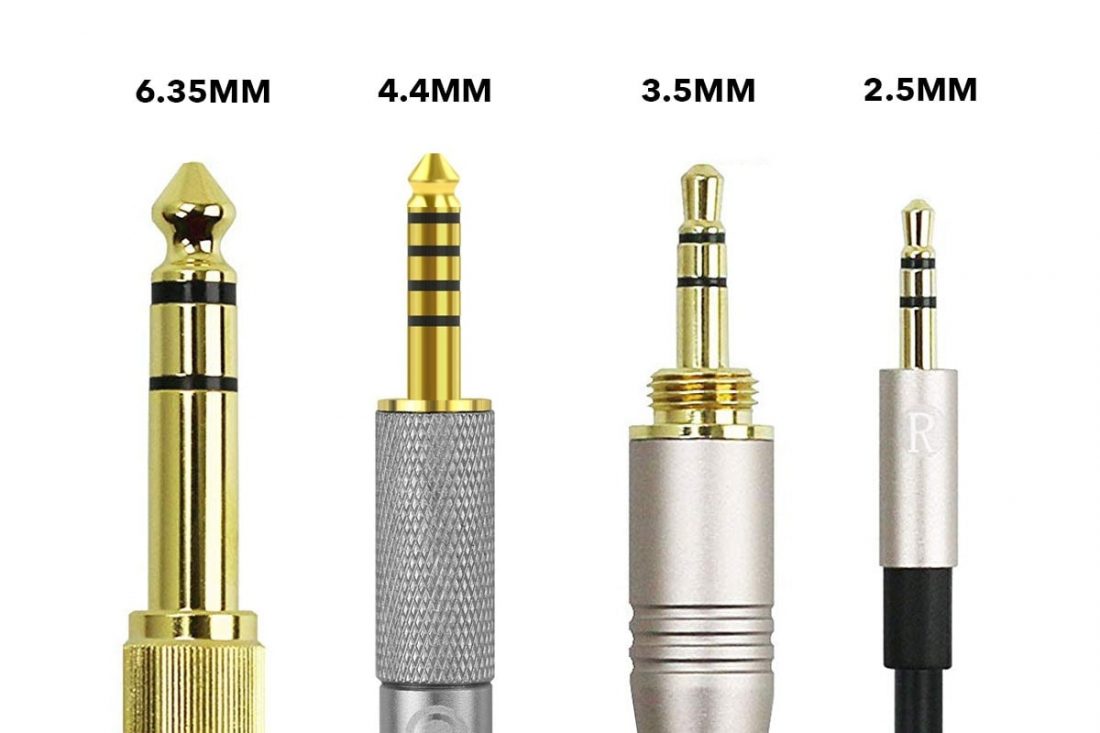
When nosotros describe the size of the headphone jack or plugs, nosotros are referring to the diameter of the connector.
- 6.35mm Connector
This is the largest connector among the jacks. It is otherwise known equally the ¼ inch connector.
| Name | Size | Conductors |
|---|---|---|
| UGREEN Stereo Audio Adapter | 6.35mm Male to three.5mm Female | TRS |
| UGREEN Stereo Audio Cable | 6.35mm to 3.5mm | TRS |
- 4.4mm Connector
| Name | Size | Conductors |
|---|---|---|
| Yinyoo Upgrated 6 Cores Copper Stereo Earphone Cable | 4.4mm to MMCX | TRRRS |
| FiiO 8-Stranded Loftier-Purity Monocrystalline Silver-Plated Copper Cable | 4.4mm to MMCX | TRRRS |
| Geekria Apollo Balanced Gold-Plated Adapter | iv.4mm male to iii.5mm female | TRRRS |
- 3.5mm Connector
Known as the miniature size or mini for brusque. You can call it a ⅛ inch too.
| Name | Size | Conductors |
|---|---|---|
| AmazonBasics 3.5mm Male person to Male Stereo Audio Aux Cablevision | 3.5mm to 3.5mm | TRS |
| Zeskit Aux Audio Cable | 3.5mm to 3.5mm | TRRS |
| Nacodex Sound Cable | 3.5mm to two.5mm | TRS |
| Kingtop Philharmonic Audio Adapter Cable | 3.5mm male to 3.5mm female | TRRS |
- 2.5mm Connector
Known as the sub-miniature or sub-mini for brusk.
| Name | Size | Conductors |
|---|---|---|
| NewFantasia Replacement Cable with Remote and Mic | ii.5mm to iii.5mm | TRS |
| NewFantasia HiFi Cable Balanced Male | two.5mm to ii.5mm | TRRS |
Why does a headphone plug matter?
A headphone plug:
- directly affects the audio signal it transmits.
- indirectly affects the overall quality of sound.
- tells us what the cable is capable or non capable of doing (mic, stereo back up, etc).
Let us start understand two basic concepts with regards to the transmitted signal from the audio source to our headphones.
Mono VS Stereo Point
Two types of signal tin exist transmitted from the audio source to the headphones
- Monaural (Mono)
- Stereophonic (Stereo)
A mono signal uses only ane audio channel while a stereo signal uses two sound channels (left and right).
Stereo point simulates "natural" hearing past creating the impression of sound coming from different directions. This is accomplished by the dissever audio channels producing audio in two dissimilar speakers (or stereo headphones). You can call this the "environment-sound" effect.
As for mono point, the sound reproduced is intended to be heard from one position.
Balanced VS Unbalanced Sound
Counterbalanced audio is all near interconnecting sound equipment and transmitting signals in a "balanced" fashion.
To practise that, nosotros need a combination of an audio source (amplifier) that can produce balanced output and a cablevision that is capable of conveying that balanced output.
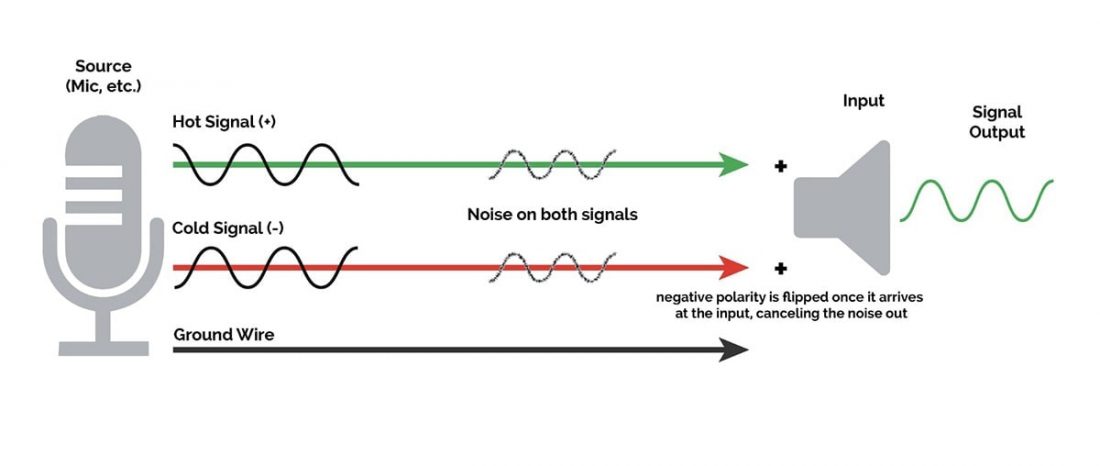
A balanced output has ii signal phases (or a hot and cold signal) per channel. Each phase has an equal impedance relative to ground, hence the name balanced.
A counterbalanced mono cable typically has at least three conductors (TRS) to carry the signal to the headphones. A balanced stereo cablevision has at to the lowest degree 5 conductors (TRRRS).
Reward of Balanced Audio
The advantage of balanced connections over unbalanced connections is the canceling of noise interference via a technique named Common Mode Rejection (CMR).
Whatsoever noise interference that hits the 2 balanced phases in the cable is imprinted equally on them. The receiving equipment (headphones in our instance) just cares about the deviation between the phases.
Then, interference that adds equally to both phases creates no difference between them and is canceled out when they are recombined by the amplifier. This canceling process of noise while preserving the original sound is known as CMR.
This means that balanced cable can run longer than unbalanced cable and operate in noisier environments because information technology cancels any noise interference.
Then when is sound unbalanced?
When the requirements to run into balanced audio are non met, the audio is considered unbalanced.
For example:
- The sound source is unable to produce a balanced output.
- The cable is not capable of conveying a balanced betoken (TS, single-ended TRS connectors).
Plug is the central
With the above 2 concepts, you lot should know that you lot tin send 4 types of point from the output (amplifier for instance) via a cable to a pair of headphones.
- Unbalanced mono
- Counterbalanced mono
- Unbalanced stereo
- Balanced stereo
Whether a signal tin be fully supported or even supported at all depends on the number of conductors found on the plug.
| Output Signal | Jack Connector | Counterbalanced Audio Connection |
|---|---|---|
| Balanced Mono | TS | N |
| Counterbalanced Mono | TRS | Y |
| Unbalanced Stereo | TRS | Y |
| Balanced Stereo | TRS | North |
| Balanced Stereo | TRRRS | Y |
Is it confusing?
It can be difficult to digest if you are reading all this for the first time. The role where stereo uses two channels and balanced audio needing two copies of the same signal with reverse polarity tripped me upwards pretty good, too.
An easy way to understand is to starting time admit that nosotros need conductors to transport and acquit signals.
The more than signals nosotros need to send, the more conductors we demand.
For example, if we want to transport a balanced stereo bespeak, information technology needs to send
- i right channel (R+),
- one flipped correct channel (R-),
- one left channel audio (L+),
- one flipped left channel audio (L-).
In total, it needs 4 signal wire and one ground wire which only a TRRRS connector tin can provide.
Thus, if a jack with an inadequate connector is used (like a TRS connector), the headphone doesn't receive the complete set of signals to do the CMR. Hence, the whole audio connection becomes unbalanced.
Let's Exercise Our New Skill
Let's run into if we tin put our new-plant skill to good apply.
Call up the "3 pole mini" term we mentioned right at the start of the article? What do yous think it means?
iii Pole Mini
Ans: 3.5mm TRS jack
Stereo Mini
Ans: three.5mm TRS jack (Bonus Qns: why do we remember is TRS and not TS?)
three.5mm single-ended cable
Ans: iii.5mm TRS jack (Bonus Qns: Is this a balanced cablevision?)
two.5mm balanced cable
Ans: 2.5mm TRS jack that can comport balanced signals

Do yous run across that the FiiO Q5 had two outputs? I with a headphone logo, another with "BAL" sign. Exercise you understand what that means?
Lastly, another practice question.


See if y'all can read the "Headphone Output" specifications of the Sony TA-ZH1ES and understand what they mean.
If you do, congratulations! You just leveled up your audiophile cognition.
Practise you similar this article? Did we miss anything? Let us know in the annotate section beneath.
Source: https://www.headphonesty.com/2019/04/headphone-jacks-plugs-explained/
0 Response to "Radio Shack Family Favorites 5 in 1 Remote Pdf"
Post a Comment